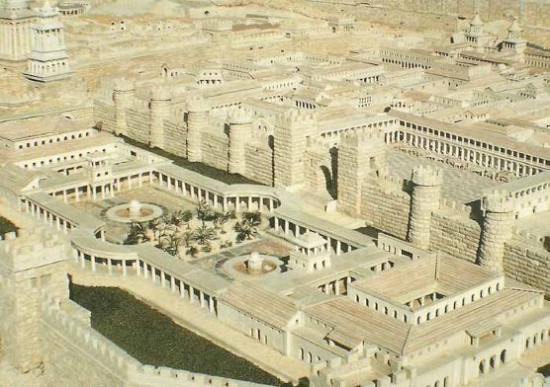
Michal and I were about to explore a virtually unknown archeological site dating back 2000 years, one that is generally inaccessible to tourists. Amit, the young archeologist who has worked for more than a decade on the Herod’s Palace site in Jerusalem, led our group on a recent tour in Jerusalem’s Old City. We met at Jaffa Gate, which is easily accessible from the Mamilla pedestrian mall, built on what was “no man’s land” from 1948-1967.
We walked behind David’s Citadel, the venue for Jerusalem’s excellent municipal museum. After ascending the Old City’s exterior wall via a steep circular staircase, past more antique wall ruins from previous periods, we were on the Ramparts Walk, at the top of the most recent, Ottoman-built, section of the Old City wall. We entered a 19th century building, built for use as a “kishle” (the Turkish word for winter barracks) for soldiers in the time of Ottoman rule, which ended during WWI.
Inside, lamps ensure a good view on the vertiginous dig. In the 150 feet long rectangular building, it looks like an impossible ski slope or a place where it is easy to commit a murder, with some gruesome deep pits. The facades are still standing, and the roof has been left undisturbed. The kishle was later used as a prison by the Turks, British and the Jordanians. On the east side there are barred windows, and on the wall are the prisoners' graffiti in English, Arabic and Hebrew. (www.bibleinterp.com/articles/schaalje_herodspalace.shtml))
The ruined kishle is only the most recent usage of this venerable location. Josephus, the Jewish turncoat historian of the 1st century CE, wrote glowingly in The Wars of the Jews about the Palace of King Herod (37-4 BCE), which bordered on the south side of David’s Citadel. The palace was constructed on a platform, about 100 feet (from north-south), and 180 feet (from east-west). The palace consisted of two main buildings, each with its banquet halls, baths, and accommodations for hundreds. It was surrounded with groves of trees, canals, ponds studded with bronze fountains and numerous porticoes where the inhabitants and guests could relax. A “wondrous” walled resort, it had luxurious bedrooms for 100 guests and abundant gold and silver fittings. The gardens were fed by a network of deep canals and underground cisterns that collected rainwater. The water taps were enclosed copper statues. (This luxurious complex was only one of several palaces Herod built for himself.)
Earlier excavations outside the city walls during the 1970s had uncovered the exit of a water drain belonging to Herod’s palace. The drain transported water and sewage from the palace into the Hinnom valley. The other end of the drain was dug up in excavations at the kishle. The pipe is big enough for humans to creep through. It was probably used for that purpose during the First Jewish War, when Jewish rebels fled the city via the sewers of Herod’s Palace. Around 70 CE, the Roman general Titus (later Emperor Titus) set up the Tenth Legion’s camp in the Palace sector. Titus destroyed the Temple, expelled the Jews from the city and renamed it Aeolia Capitolina. The Palace was a Roman stronghold, from which Rome controlled Israel for 200 years. It was eventually destroyed by Jewish rebels during their revolt against Roman rule.
Standing at a substantial depth below the prison floor, we observed the remains of eight pools which had once been used as dye vats. It was thrilling to see an original Hasmonean city wall, dating to the 3rd century BCE. After the 7th century CE Arab conquest, Mohammed Ali from Egypt took over the walled city. Against the eastern wall, Crusader arches are visible. In the western wall, there is evidence that the Crusaders fortified and heightened the 15-foot thick Hasmonean wall, which was a common practice.
There is an even older wall from King Hezkiyahu’s era, which was around 700 BCE. He built the Siloam Tunnel in the nearby City of David, a 1,500-foot-long-tunnel dug to protect Jerusalem’s water source, the Gihon Spring, from the invading Assyrians (2 Chronicles. 32:2-4). The most astounding finding on the site is a late-Israelite wall from the period of the kings who followed David and Solomon, dating from before 587 BCE. This wall lies well inside the Herodian and earlier Hasmonean walls of the Palace. The stones are a lot smaller than those in the Herodian wall, but they still stand fast.
Further excavation at this rich historical site is unlikely because of a lack of funds. An additional impediment to developing the site is that it is constrained by the Old City police station in one direction and David’s Citadel in the other.
We ended our tour next to the site on Mt. Zion. On our way back to Jaffa Gate, we enjoyed the fantastic view across the Hinnom Valley to west Jerusalem. We passed the axle for a thin cable stretching across the narrow valley, which allowed Jewish soldiers occupying a stronghold on Mt. Zion to be supplied during the War of Independence. Israel lost control of the Old City to the Jordanians during this war and Jews were prohibited from visiting the Old City and its religious sites for nineteen years. Jerusalem was reunited when Israel was victorious in the Six Day War of 1967, allowing people of all faiths to visit the highly significant ancient city. Today it’s possible for a group like ours to enjoy historical sites throughout Jerusalem.
See the new website: www.encounteringisrael.com
 dear editor 159 magazine
dear editor 159 magazine OVERNIGHT OAT & SESAME BARS
OVERNIGHT OAT & SESAME BARS IN THE SWIM
IN THE SWIM A new website in English - on Volunteering - Launched in Israel
A new website in English - on Volunteering - Launched in Israel Help Needed for Abused Horses and Donkeys
Help Needed for Abused Horses and Donkeys Heather's Heseg
Heather's Heseg Steve Kramer
Steve Kramer